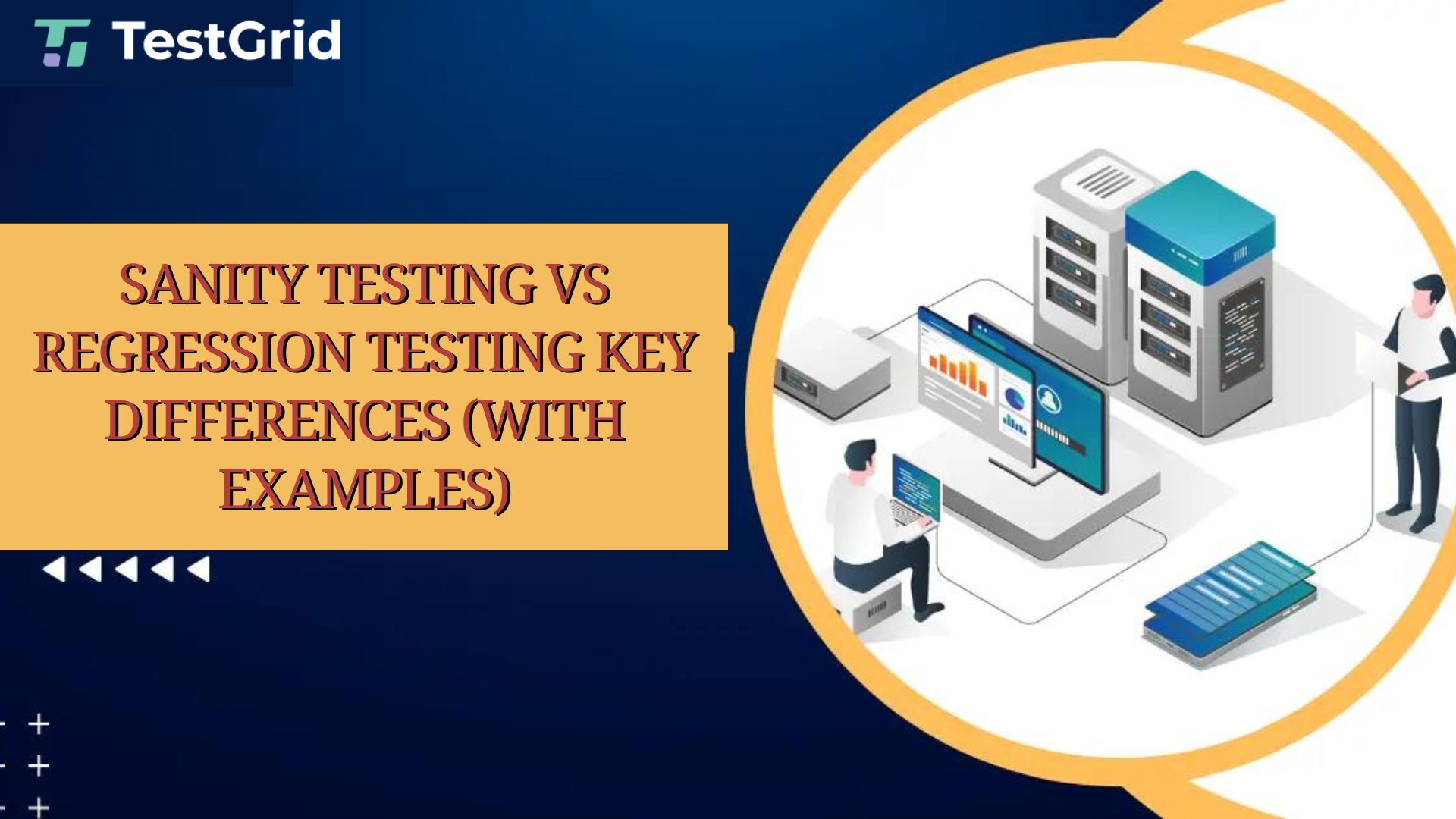Sanity Testing Vs Regression Testing Key Differences (with Examples)
 Steve Wortham
Steve Wortham
The two most common software testing techniques used by QA engineers are Sanity and Regression testing. However, there are some differences between them that most of them are unaware of.
This article will try to clarify any confusion and explain things in detail.
Sanity Testing and Regression Testing: Purpose, Cost & Advantages Comparison
Let’s us start comparison between regression and sanity testing by considering various aspects like why and when they are used, cost, advantages & different phases of testing stages.
What is Sanity Testing?
Sanity testing is used to determine whether a software product is functioning correctly after adding a new module or functionality to an existing product. Sanity testing is a software testing technique that performs a quick evaluation of the quality of a software release to determine whether it is eligible for additional rounds of testing.
What is The Purpose of Sanity Testing?
The primary function of sanity testing is to ensure that the changes or proposed functionality work as expected. If the sanity test fails, the testing team rejects the software product to save time and money. It is only performed after the software product has passed the smoke test and is accepted by the QA team for further testing.
What is The Cost of Sanity Testing?
The cost of the project goes up in the case of sanity testing.
When Sanity Testing is Executed?
After many regressions or a minor change in the code, a build is received.
After bug fixing, the build is delivered.
Before the production deployment.

Regression Testing
What Are The Reasons to Conduct Sanity Testing?
The Need for Speed:
- The first reason to use a sanity check is for speed. Nobody would refuse some buffer time to fix the discovered bugs. However, this testing is limited in scope and has clearly defined examination areas. This testing can be done intuitively without a specific test case.
No Extra Effort Is Necessary:
- Second, the sanity check keeps you from doing anything you don’t need to. It indicates whether additional tests should be performed. This eliminates extra work but gives the test team more time and simplifies the process by eliminating formal bug reporting.
Identifying Outward Issues:
A sanity check reveals deployment issues. For example, the tester might encounter an inaccurate user interface if the developers did not include all the resource files in the compilation.
Furthermore, developers may fail to specify some critical features to make them visible to testers. A sanity check detects such issues and provides a quick solution for a stable release.
Quick Responses:
Finally, a test quickly defines the product’s status and predicts the next steps. In the event of a failure, you can direct your test team to resolve the issues discovered before the product release before moving on to the next task.
Simultaneously, if you pass this test, you can ask your team to move on to the next task, involving only one developer or tester in the modifications and fixes, or you can set aside some time to correct the errors.
Advantages of Sanity Testing:
It aids in the rapid identification of issues in the core functionality. As a result, the application’s stability can be validated quickly, and any problems can be reported and fixed quickly.
Because no documentation is required, these tests can be completed less than other formal tests.
If problems are discovered during Sanity testing, then the build is rejected. This saves a significant amount of time and resources that would otherwise be used to run regression tests.
To Perform Sanity Testing, Three Phases Must Be Completed:
Identification:
Identifying new modules, features, and functionalities is included in this step. Along with this, the tester must keep an eye on any changes or modifications that may have been made to the code while bugs were being fixed.
Evaluating:
This step entails inspecting the newly implemented features and determining whether or they’re not functioning as intended.
Testing:
The final step entails a random examination of all the parameters, elements, and functionalities.
Best Practices of Sanity Testing
This type of testing is carried out following new functionality to a system.
This type of testing is performed after new functionality is added to a system.
Adopting this type of testing would be pointless if no new functionality was added to a system.
What Is Regression Testing?
Regression testing is software testing used to ensure that a recent program or code change has not negatively impacted existing features. Regression testing is simply a full or partial selection of previously executed test cases that are re-executed to ensure that existing functionalities continue to function properly.
This testing ensures that new code changes will not impact existing functionalities. Instead, it ensures that the old code continues to function after the most recent code changes have been made.
What is The Purpose of Regression Testing?
Regression testing is performed after running sanity tests on any changed functionality, which leads to Quality Assurance and related functionalities. Only the QA team is responsible for this. Regression testing is the final step in the testing cycle and examines the overall product behavior.
When performing regression testing, always make sure that the code under test is managed by a configuration management tool and changed while the test is running. Furthermore, the QA team should only use a separate database.
What is The Cost of Testing
The cost/budget of testing goes up in the case of regression testing, but with automation, regression cost, and ROI go up.
When Regression Testing Is Executed?
Regression testing is usually performed after changes or new functionality has been verified. However, this is not always the case. Regression tests must be included in the daily test cycle for the release, which will take months to complete. When Functional Testing for the changes is completed for weekly releases, regression tests can be performed.
Regression checking is a retest type. The reason for retesting can be anything. For example, assume you were testing a specific feature, and it was the end of the day; you couldn’t finish testing and had to stop the process without determining whether the test passed or failed.
When you return the next day, you repeat the test – this means you are repeating a previously performed test. A Retest is simply the act of repeating a test.
A regression test is essentially a retest. Something in the application/code has changed only for this special occasion. It could be code, design, or anything else that governs the overall framework of the system.
The Regression Test is a retest performed in this situation to ensure that the said change has not impacted anything that was previously working.
The most common reason for this is that new code versions have been created (due to an increase in scope/requirement), or bugs have been fixed.
Best Practices For Regression Testing:
#01 Automated Regression Testing
Regression test cases are the best type of test cases for automaton. Typically, when an organization begins automating, these are the first test cases to be automated. For example, if regression testing consumes a significant amount of time for your testers and the same test cases are repeated multiple times, it is time to consider automation.
If you’re looking for an automated regression testing tool to help you get started on your automation journey, you’ll want to make sure you pick the right one. A tool that can also provide you with an ROI on your efforts.
#02 Maintain And Regular Revise Regression Pack
The regression pack is primarily a collection of test cases run whenever new software is installed. The scripted tests included in a pack are designed with older software versions’ prerequisites in mind.
Testers can easily integrate ad hoc or random tests into the pack. Regression tests can be time-consuming and tedious; the last thing you need is to count tests to see if a defunct feature is still functional.
#03 Give Extra Attention To Highly-Trafficked Paths
The most persistent use cases for an app are high-trafficked methods. Such paths incorporate the app’s critical functionality and prominent features.
Therefore, it is essential to understand the core customers and the standard highlights, traits, and collaborations they are most reliant. In addition, the effective regression tests pack must integrate tests that ensure this core feature performs as expected.
#04 Run A Full Regression Suite Only When Needed
Running the entire regression suite on every build is not always necessary. However, in the case of a minor release, it is prudent to run or execute only the smoke tests and regression testing for any modules that have changed.
To keep things simple, organize the test cases in regression testing according to the module of the AUT covered by each test.
For example, suppose the release includes a change to the payment options accepted by an online store. In that case, it is best to run regression testing for the payment procedure but skip regression testing for other features such as finding items and adding them to the cart.
#05 Repeat Test Cases
Tests that have previously identified bugs and glitches should be included in your regression test pack. Tests that the program passes, on the other hand, are better candidates for authenticity.

Regression Testing
Conclusion:
In summary, testing is a significant activity in the software development life cycle. Furthermore, there are two types of testing: sanity and regression.
The main distinction between sanity and regression testing is that sanity testing helps test the system’s critical functionalities before performing major testing.
Source: This article was originally published at https://testgrid.io/blog/sanity-testing-vs-regression-testing/.
Subscribe to my newsletter
Read articles from Steve Wortham directly inside your inbox. Subscribe to the newsletter, and don't miss out.
Written by

Steve Wortham
Steve Wortham
Experienced Software QA Manager passionate about delivering top-quality software, writing intuitive content, and fostering connections with industry peers.